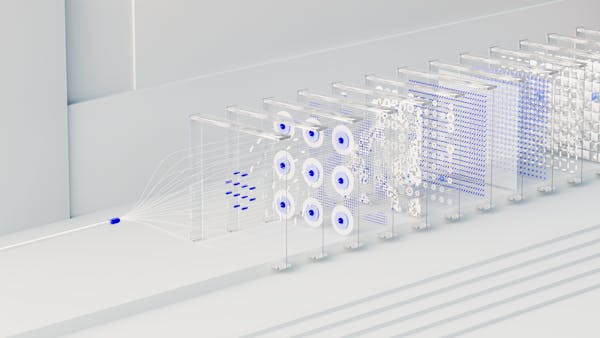Cloud computing refers to the delivery of computing services over the internet ("the cloud") instead of relying on local hardware or infrastructure. In this model, users can access computing resources, such as servers, storage, databases, networking, and software applications, ondemand from cloud providers.
Cloud computing has revolutionized the way businesses and individuals consume computing resources. Its scalability, flexibility, and cost-effectiveness have made it an essential component of modern IT infrastructure.




Artificial Intelligence (AI) is a branch of computer science that aims to create intelligent machines capable of simulating human cognitive functions such as learning, problem- solving, reasoning, and perception. AI technologies enable machines to perform tasks that typically require human intelligence.

Machine Learning: ML algorithms typically use traditional statistical techniques to analyze structured data. Common ML algorithms include linear regression, decision trees, support vector machines (SVM), and random forests. ML models require feature engineering, where relevant features of the data must be manually selected and extracted.
Deep Learning: DL algorithms are based on artificial neural networks, which consist of interconnected layers of nodes (neurons). Each layer processes the input data and extracts increasingly complex features. Deep Learning architectures include Convolutional Neural Networks (CNNs) for computer vision, Recurrent Neural Networks (RNNs) for sequential data, and Transformer models for natural language processing.
Machine Learning: ML is widely used in various applications such as spam email detection, customer segmentation, credit scoring, recommendation systems, and predictive maintenance. It is effective for tasks with structured data and well-defined features.
Deep Learning: DL excels in handling unstructured data such as images, audio, and text. It powers applications like image recognition, speech recognition, language translation, autonomous vehicles, and game playing (e.g., AlphaGo). DL models automatically learn features from raw data, reducing the need for manual feature engineering.
Machine Learning: ML models can be trained using relatively simpler algorithms and require less computational resources compared to DL. Training ML models often involves tuning hyperparameters and optimizing feature selection to achieve desired performance.
Deep Learning: DL models are more complex and require large amounts of data and computational power for training. Training deep neural networks (especially with many layers) often involves techniques like gradient descent optimization and regularization to prevent overfitting.
Machine Learning: ML models are generally more interpretable and transparent, as the relationship between input features and predictions can be understood through feature importance analysis and model explainability techniques.
Deep Learning: DL models, especially deep neural networks with multiple hidden layers, are often considered "black boxes" due to their complex architectures. Understanding how DL models arrive at specific predictions can be challenging, limiting their interpretability.
Machine Learning: ML models are generally more interpretable and transparent, as the relationship between input features and predictions can be understood through feature importance analysis and model explainability techniques.
Deep Learning: DL models, especially deep neural networks with multiple hidden layers, are often considered "black boxes" due to their complex architectures. Understanding how DL models arrive at specific predictions can be challenging, limiting their interpretability.






Artificial Intelligence (AI) continues to evolve rapidly, driving innovation across various industries and transforming how businesses operate.
Here are some key future trends that are shaping the landscape of AI-driven innovation:



Explainable AI focuses on developing AI systems that can explain their decisions and outputs in a human-understandable manner.
As AI is increasingly integrated into critical decision-making processes, the ability to understand and interpret AI-generated insights becomes essential for trust, accountability, and regulatory compliance.
XAI will be crucial in domains such as healthcare (interpreting medical diagnoses), finance (explaining credit decisions), and autonomous systems (providing transparency in selfdriving cars).
AI ethics addresses the ethical implications of AI technologies, including issues related to bias, fairness, transparency, and privacy.
Ensuring ethical AI practices is paramount to building trust with users, mitigating risks, and fostering responsible AI development and deployment.
Implementing ethical AI principles across industries to address bias in algorithms, protect privacy in AI-driven systems, and promote fairness in AI-based decision-making.
Edge AI involves deploying AI models directly on edge devices (e.g., smartphones, IoT devices) rather than relying solely on centralized cloud servers. Federated learning enables training AI models collaboratively across decentralized devices while preserving data privacy.
Edge AI and federated learning enable real-time processing, reduce latency, and address privacy concerns associated with centralized data storage.
Edge AI powers smart IoT devices, enables offline AI applications on mobile devices, and supports privacy-preserving AI in healthcare and finance.
AI-augmented development involves using AI tools and techniques to automate and optimize software development processes.
AutoML (Automated Machine Learning) accelerates model training and deployment, while AI-driven DevOps streamlines software development, testing, and deployment cycles. AI-augmented development enhances productivity, facilitates rapid prototyping, and enables the creation of intelligent applications across industries.
Human-AI collaboration focuses on leveraging AI technologies to augment human capabilities rather than replace them.
AI-driven tools empower humans to make better decisions, enhance creativity, and solve complex problems more efficiently.
AI co-creation supports personalized education, assists professionals in complex tasks (e.g., medical diagnosis, legal research), and fosters innovation through AI-driven ideation and design.
Vertical AI refers to customized AI solutions tailored for specific industries or use cases.
Industry-specific AI applications optimize workflows, drive operational efficiency, and unlock new opportunities for innovation and growth.
Vertical AI is prevalent in healthcare (precision medicine), finance (algorithmic trading), manufacturing (predictive maintenance), retail (personalized marketing), and more.
AI-driven innovation is poised to revolutionize industries and create new opportunities for businesses and society. Embracing future trends in AI, such as explainability, ethical AI practices, edge computing, AI-augmented development, human-AI collaboration, and industry-specific applications, will be crucial for organizations to stay competitive and harness the full potential of AI technologies.